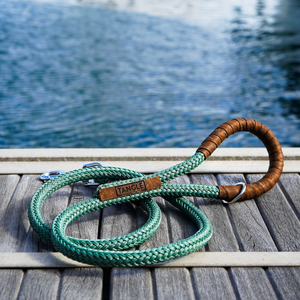In an attempt to help address the Ghost Net problem, we’re recycling end-of-life fishing nets into new, long-lasting pet products, like our sustainable dog lead.
By the team at Tangle
By now, we’re getting to a point where the majority of people are aware of the ocean plastic problem. It’s refreshing to see businesses and industries moving away from a reliance on single use plastic. We’ve all seen the images of marine life caught in a plastic bag or their stomach full of micro-plastics but there’s a plague on our ocean that’s completely under the radar. And it’s far more dangerous: Ghost Nets.
The Ghost Net Problem
Ghost Nets are fishing nets that have been abandoned, lost or otherwise discarded in the ocean. In some cases they can be up to 6 miles long and the reason they get there is largely down to the fishing industries laziness or lack of accountability. Their danger comes from their effectiveness – once a fishing net becomes a Ghost Net it carries on doing what it does best: catching, entangling and killing marine life.
Ghost Nets don’t distinguish what they’re catching though. They entangle and kill everything including turtles, sharks, dolphins, whales and seabirds – at an annual rate that is well into the millions. The United Nations Environment Programme (UNEP) estimates that 640,000 metric tonnes of Ghost Nets enter the ocean ecosystem every single year.
Nylon nets, often made from harsh plastics that take centuries to degrade, tangle on rocky reefs or drift across the open seas. Nets that do breakdown never go away; they just become smaller pieces of plastic. Marine animals mistake this microplastic for food and eat it, harming their internal organs, stopping them from eating, and exposing them to toxic chemicals.

1. Poor access to disposal/recycling facilities. It’s often easier to get rid of unwanted fishing gear by throwing it overboard instead of bringing it back to shore.
2. Destructive fishing techniques. Bottom trawling (scraping the seabed of all life), will often cause nets to snag on the seafloor and break.
3. Catch overload may damage the integrity of the net used, often resulting in breakages and improper disposal of the damaged nets. Some fisheries dump their net overboard due to lack of space onboard following a successful catch.
4. High cost of retrieval discourages fishermen from recovering lost nets, which can also be time consuming. Buying a new net is often cheaper.
5. Poor weather conditions dislodges set fishing gear, resulting in misplacement when at sea.
Ghost gear is a global issue. It occurs anywhere in the world where fishing takes place, and hundreds of thousands of miles beyond that too. Ocean currents cause ghost gear to drift far from its origin and across countless borders. As a result, the gear can often end up all over the world on beaches, coral reefs and in the deep sea.
The problem of ghost nets has been known for years. But research showed that none of the 15 largest fishing companies in the world are including this problem on their agenda, let alone are taking action to prevent their fishing nets from being left behind in the sea. And even though one company mentions the problem, none reports on it.
Governments are also largely failing in this regard. Up until now, it’s been impossible to identify from which ship a ghost net came from. As a result, governments can’t recover the clean-up costs so they do nothing about the problem. The sad truth is that as long as there’s no effective international control system, fishing vessels are going to continue to dump their old nets into the sea without punishment.

(Ocean Voyage Institute)
Solving the Ghost Net Problem with Tangle
This needs to stop. People need to take action.
We’re bored of big corporates saying they’ll take action when they’re simply greenwashing… faking statistics and support of such causes, just to increase their bottom line. Tangle is here to spark change.
To spread the word about the Ghost Net problem, we’re recycling these end of life fishing nets into new, long-lasting pet products. The first is our Ocean Green sustainable dog lead, made from end of life fishing nets.
By adopting this process, we’re stopping Ghost Nets at source. Ghost Nets get into our oceans after they’re either dumped or discarded by fisheries so we want to gets nets before they become Ghost Nets. After all, if a pipe was leaking you’d turn off the source of the water first, not cover the pipe – we adopt the same view for Ghost Nets.

Here’s how we do it:
We start by collecting end of life fishing nets from a range of ports, net makers, and collection partners globally (to prevent them being disposed overboard at sea which is often most convenient for lazy fisherman).
We recycle these nets through a process of deconstruction, sorting and fractioning into different types of plastics and colours. The material is then shredded, washed, separated and dried. Lastly, we compound and extrude it into 100% recycled green pellets.
For this particular product the pellets are extruded and spun into our proprietary Tangle yarn. From there we create the sustainable Tangle dog lead you see today. What we found is that fishing nets actually make for the perfect resource when making products for dogs. It’s lightweight and waterproof, so unlike other dog leads, it doesn’t get soggy and start to smell after a few walks.
We’ll be launching other products that save our oceans and stop Ghost Nets, so if you’re keen to follow our journey, stay in touch on our website here.



